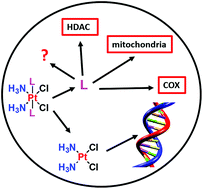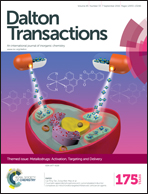Platinum(iv) anticancer prodrugs – hypotheses and facts
Abstract
In this manuscript we focus on Pt(IV) anticancer prodrugs. We explore the main working hypotheses for the design of effective Pt(IV) prodrugs and note the exceptions to the common assumptions that are prevalent in the field. Special attention was devoted to the emerging class of “dual action” Pt(IV) prodrugs, where bioactive ligands are conjugated to the axial positions of platinum in order to obtain orthogonal or complementary effects that will increase the efficacy of killing the cancer cells. We discuss the rationale behind the design of the “dual action” prodrugs and the results of the pharmacological studies obtained. Simultaneous release of two bioactive moieties inside the cancer cells often triggers several processes that together determine the fate of the cell. Pt(IV) complexes provide many opportunities for applying new concepts in targeting, synergistic cell killing and exploiting novel nanodelivery systems.

- This article is part of the themed collection: Metallodrugs: Activation, Targeting, and Delivery

 Please wait while we load your content...
Please wait while we load your content...